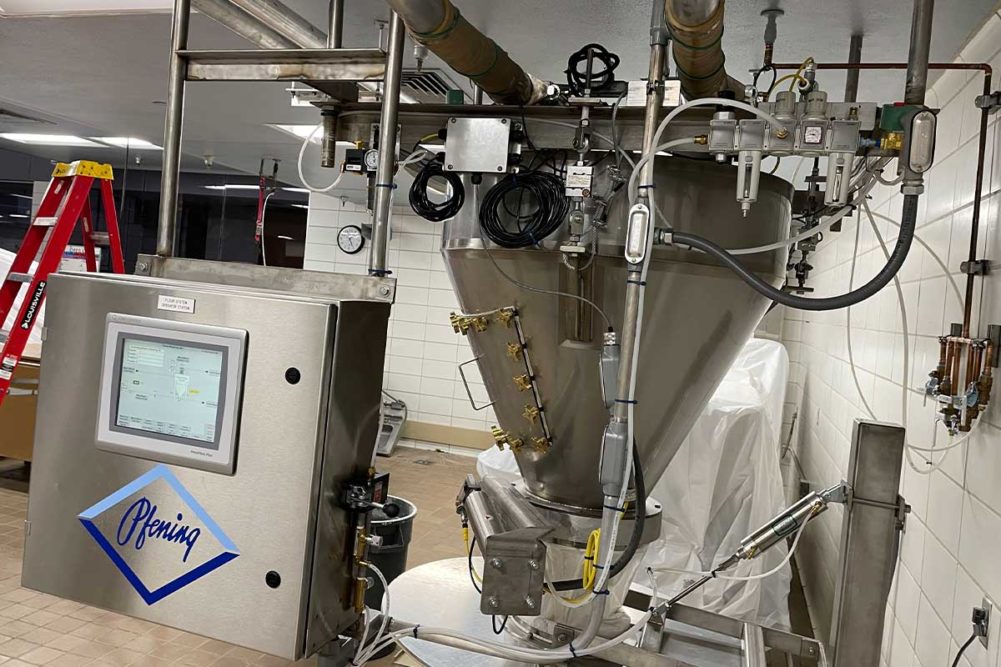In most bakeries, the bulk of labor can be found in two places: the very beginning of the process in ingredient handling and mixing and the very end of the process in packaging. At the front-end of production, reliable, experienced labor is critical to finished product quality and production efficiencies when a bakery has limited automation.
“If you’re performing manual weighing tasks for ingredients, it’s time- and labor-intensive, and you’re not guaranteed quality or consistency,” said Mike Miller, director of sales, food, AZO Inc.
Reducing labor has always been an advantage of automated ingredient handling systems in addition to increased accuracy and capacity, but this point has become even more critical during the past three years as baking companies struggle not only to find employees but keep them.
“The biggest issue facing the baking industry — any industry, really — is an experienced labor force and, second, a reliable labor force,” said Darren Adams, vice president, engineering, The Fred D. Pfening Co. “You need someone who can do the job, knows the job and can bring things to the table. That labor force seems to be less and less available while the need seems to be growing, so we find ourselves in a constantly diminishing situation.”
As baking companies expand their workforce search beyond experienced employees with baking knowledge, they run into an issue of reliability and need to accommodate for the lack of experience. Relying on an unskilled workforce, especially in an area of the bakery that is so critical to finished product quality, poses a risk many baking companies aren’t willing to take.
“You don’t have to worry about the system showing up to work. It’s going to work every day, it will do it right every time, and it doesn’t need to be re-trained,” said Jason Stricker, vice president of sales and marketing, Shick Esteve. “That’s always been true, but with the confluence of everything around labor, it’s changed our customers’ return on investment. In some cases, it was labor savings and reduction, but now they are considering risk avoidance as well. When you’re automating, whether it’s up front in ingredient handling and mixing or in the back at packaging, the less reliant you are on people, the less risk you incur to both production capacity and product quality.”
Planning ahead, digital controls and robust training all help baking companies incorporate and adapt to these automated systems and ensure that they’re optimizing their capabilities while also reducing headcount.
When automating ingredient handling, baking companies often first look at bulk ingredients and then minors. Bulk ingredient handling can eliminate virtually all labor: Ingredients come in on truck or rail, are pumped into silos or bins and then transferred into the mixer all without a human hand involved. Minor handling systems, on the other hand, can certainly remove much of the skill required for scaling and adding them to the dough. However, it can only minimize labor, not eliminate it entirely.
“The smaller ingredients will still have an element of labor because of the packaging sizes,” Mr. Stricker explained. “A person still has to stage the supersacks or the 50-lb bag has to be emptied into a vessel that feeds the automated systems.”
When adding this automation, planning is critical. These systems are expensive and often must be invested in and installed in increments. Without looking ahead, baking companies can miss opportunities to streamline efficiencies.
“If a customer is considering putting together an automation plan or looking to expand, it’s important to think about it in terms of the end goal and where they are today and put together a plan that addresses key areas along the way, so they can build the plan out incrementally,” Mr. Miller said. “Often, we have conversations with customers who don’t have any automation, and it’s a binary mindset. We can help you figure out the plan and build out the incremental steps that make good financial sense based on what is needed today and tomorrow.”
Bakers also need to consider challenges that have nothing to do with the production efficiencies, and these need to be evaluated in light of the bakery’s main goals, in this case, labor reduction and efficiency.
“Height and layout limitation and restricted budget are some of them,” said David Rodrigues, sales engineer for USA West Coast and Latin America, Zeppelin Systems USA. “Zeppelin believes that understanding the real necessity of the client is the right way to approach these issues by aiming automation efforts at the ingredients with larger consumption and labor dependence. This way the system can be designed to fit the customers’ current situation and still be suitable for future expansions.”
Bakeries managing many different products and the changeovers they require will also need to be attentive to ingredient usage when planning their ingredient handling system. Changeovers are typically seamless with the help of software systems, but they go more smoothly when bakers take the time to be intentional about which ingredients should be automated and which should be handled manually.
“When dealing with a high number of ingredients and changeovers, the best thing you can do is carefully plan out what you’re going to automate, and those are the ingredients that are most frequently used in a lot of different recipes,” Mr. Stricker said. “A careful analysis of your next tier of ingredient usage and how those can be automated as well is also really important.”
This article is an excerpt from the April 2023 issue of Baking & Snack. To read the entire feature on Ingredient Handling, click here.





